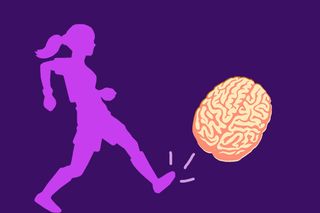
Leg Exercise Is Critical to Brain Health
It’s not all about abs and biceps.

If you’re thinking of hitting that snooze button and skipping on your morning jog, you might want to think again.
New research shows that neurological health is not only dependent on signals from the brain to the muscles, but is also equally dependent on signals sent from the body’s large leg muscles to the brain. The new study, published in Frontiers in Neuroscience, brings a new perspective to brain and nervous system medicine, which made lead to a better understanding of why patients with motor neuron disease, multiple sclerosis, spinal muscular atrophy and other neurological diseases often experience a rapid decline when their scope of movement diminishes.
“Our study supports the notion that people who are unable to do load-bearing exercises — such as patients who are bed-ridden, or even astronauts on extended travel — not only lose muscle mass, but their body chemistry is altered at the cellular level and even their nervous system is adversely impacted,” says Dr. Raffaella Adami from the Università degli Studi di Milano, Italy.
In the study, researchers used mice, restricting the use of their hind legs for a period of 28 days. The mice continued their day to day activities, which any signs of stress. At the end of the trials researchers then analyzed the sub-ventricular zone, and area in the brain responsible for maintaining nerve cell health in mammals. This is also where neural stem cells produce new neurons.
They found that limiting the activity of the hind legs in the mice had decreased the number of neural cells by 70%, as compared to those mice that were allowed to roam freely. What’s more both neurons and specialized olidodendrocytes – specialized cells that support and insulate nerve cells, didn’t completely mature when exercise was extremely limited.
Using the legs, especially in weight-bearing exercises, sends the brain signals that are vital in producing healthy neural cells – crucial in brain and nervous system. Hence, less exercise for the legs means lower production of nerve cells, which are essential in contributing to our ability to cope with stress and adapt for challenges.
“It is no accident that we are meant to be active: to walk, run, crouch to sit, and use our leg muscles to lift things,” explains Adami. “Neurological health is not a one-way street with the brain telling the muscles ‘lift,’ ‘walk,’ and so on.”
Researchers further analyzed individual cells and found that limiting limb exercise reduces the oxygen levels of the body, thus creating an anaerobic environment and altered metabolism. It also seems to affect two genes, one of which is vital in the functioning of mitochondria, which is the powerhouse, the source that gives energy for the body to use.
These results are important in highlighting the numerous health issues that result from sedentary lifestyles that limit leg exercise every day. But it also helps scientists to better understand devastating diseases such as spinal muscular atrophy (SMA), multiple sclerosis, and motor neuron disease.
“The question I asked myself was: is the outcome of these diseases due exclusively to the lesions that form on the spinal cord in the case of spinal cord injury and genetic mutation in the case of SMA, or is the lower capacity for movement the critical factor that exacerbates the disease?” speculates co-author Dr. Daniele Bottai, from the Università degli Studi di Milano.
The research will help in better understanding the critical impact that movement plays in neural health.
Angelina Shah is a staff writer with The Swaddle. In her previous life she was a copywriter in advertising. She has a penchant for reading, singing, travelling and being obsessed with superheroes.
Related


Private Cord Blood Banking Is Mostly Ineffective, Says IAP
